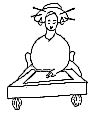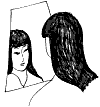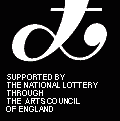Objectives
By the end of this lesson you should
» know the principal characteristics of poetic language and
» be able to distinguish poetic language from academic language
» be in a position to apply your learning to redrafting your own poems
Poetry works through images, not explanations. Let us identify images and explanations.
You know what explanations are. Here is a working definition of "images:" An image brings some scene, object or observation alive, and presents it to your imagination, so that you can picture it, or feel as though you experience it.

STUDY
Identify the image.
The following are set out as haiku poems, in themed pairs, but some of them are explanations, which are not really suited to be poems and would be more appropriate as sentences in essays. Which ones are images, and which are explanations? Write "image" or "explanation" next to each one.
Nature and religion
To live is to suffer;
religion offers comfort
and hope
Contending –
temple bell
winter wind
Looking
Telescope –
eyeful of haze,
three pence.
You can’t always
find what you seek,
as you’d hoped.
Shopping
Swinging homeward
with my shopping: muddy leeks,
the weight in the base.
It is a pleasure
to buy good food
and plan a meal.

WRITE
What are the differences between the images and the explanations,
1. in relation to the senses (are there sounds and smells and sensations in the poem) ?
2. in relation to concrete things and named objects?
3. in relation to the space for the readers to take part in the poem and draw their own conclusions?

REFLECTION
You will probably have noticed that, of the two pieces headed
Nature and religion, "To live is to suffer" is an
explanation written in the form of generalisations. The words "suffer" and""comfort" might make some appeal to the senses, but arise here in such general terms that they are too vague to be vivid. "Temple bell" and "winter wind" are named things. Both appeal to the sense of sound, and "winter wind" also to the tactile sense and the visual sense (one sees swirling trees and leaves). Although the only additional information we are given is that they are "contending," the whole scene comes dramatically alive and we shiver at the implications of this hostile relationship between nature at its fiercest, and civilization. "Contending …" is a particularly potent
image. It is completely "open-ended" in the sense that the reader can have any attitude to the threat of the winter wind, and any attitude to the culture represented by "temple bell," and bet on either of them to win, at any odds. "To live is to suffer," on the other hand, tells you what to think and leaves little room for argument. You cannot draw your own conclusions.
Under the heading Looking, "Telescope …" obviously appeals to the sense of sight and gives you three concrete things (telescope, eyeful of haze, and three pennies). It leaves you free to draw your own conclusions about the comic ironies of the situation. It is an image (a vividly hazy one!). "You can’t always …" has no objects vivid to the senses, no sense experiences, and closes down the options for drawing your own conclusions by assertion. It is an explanation.
Of the two Shopping pieces it is clear that the swinging muddy leeks are a very concrete image, with a particular weight, appealing to three senses (sight, smell, tactile) and "It is a pleasure …" is a generalised explanation with no detail vivid to the senses. The leek poem positively entices the reader to speculate on what might happen next, and to visualise the preparations for eating. It is full of imaginative space for the reader.
("Contending" is by Kito, translated Stryk; "Telesope" is by Issa, translated Stryk; and "Swinging homeward" is by Hirai Sachiko, translated Marsh).

STUDY
The image
SHOWS, and the explanation
TELLS.
All forms of imaginative literature, including drama and film, follow the same principle, which can be summed up in the slogan, "Show, don’t tell." Think of television drama, or your favourite films, or novels: they show you a character in a difficult situation, and leave you to judge. They do not tell you what to think (that is propaganda), though, of course, moral people are likely to reach similar conclusions in many cases.


